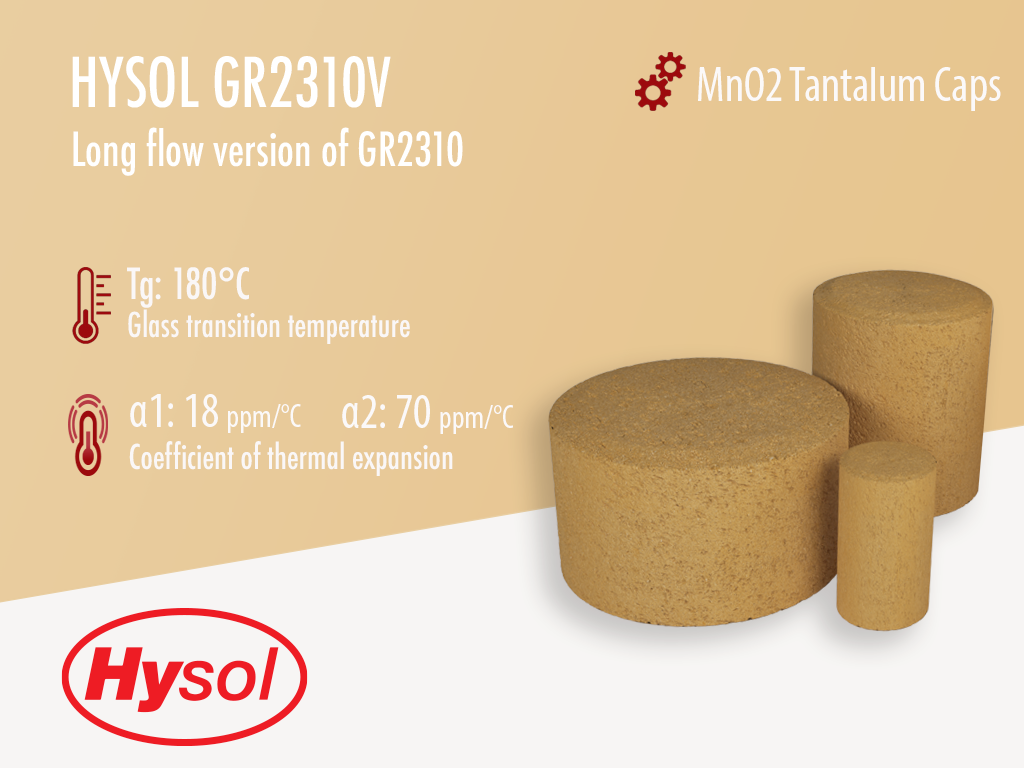Hysol GR2310V | Gold Epoxy Mold Compound
- Long flow version of GR2310
- For MnO Tantalum Capacitors
- Gold (yellow) colored
Product Description
Hysol GR2310V is a long flow, long-gel time version of GR2310. It is gold (yellow) in color and is a semiconductor-grade epoxy molding compound or duroplast designed for the encapsulation and protection of Manganese Oxide (MnO2) tantalum capacitors and automotive sensor packages. Once molded and post-mold cured, this product provides optimium protection and reliability for these capacitor devices.
Hysol GR2310V is a laser markable, environmentally "green" product, meaning that doesn't contain any halogens including bromine, antimony or phosphorus flame retardants. MG33F-0520 and MG33F-0602 dominated the space for tantalum capacitors but used halogen-containing flame retardants. This next generation epoxy mold compound replaces these older generation products. It is designed to achieve JEDEC Level 1 requirements at 260°C reflow temperature. Its fast cure time ensures that it is compatible with the latest automold manufacturing equipment. Hysol GR2310V meets UL 94 V-0 Flammability at 1/4 inch (6.35mm) thickness.
Technical Specifications
| General Properties | |||||||||
| Color Color The color | Gold | ||||||||
| Filler Content | 72 % | ||||||||
| Specific Gravity Specific Gravity Specific gravity (SG) is the ratio of the density of a substance to the density of a reference substance; equivalently, it is the ratio of the mass of a substance to the mass of a reference substance for the same given volume. For liquids, the reference substance is almost always water (1), while for gases, it is air (1.18) at room temperature. Specific gravity is unitless. | 1.85 | ||||||||
| |||||||||
| Physical Properties | |||||||||
| Spiral Flow @ 175°C | 114 cm | ||||||||
| Chemical Properties | |||||||||
| |||||||||
| Electrical Properties | |||||||||
| |||||||||
| Volume Resistivity Volume Resistivity Volume resistivity, also called volume resistance, bulk resistance or bulk resistivity is a thickness dependent measurement of the resistivity of a material perpendicular to the plane of the surface. | 1.0x1016 Ohms⋅cm | ||||||||
| Mechanical Properties | |||||||||
| |||||||||
| |||||||||
| Molded Shrinkage | 0.3 % | ||||||||
| |||||||||
| Thermal Properties | |||||||||
| |||||||||
| |||||||||
| Glass Transition Temperature (Tg) Glass Transition Temperature (Tg) The glass transition temperature for organic adhesives is a temperature region where the polymers change from glassy and brittle to soft and rubbery. Increasing the temperature further continues the softening process as the viscosity drops too. Temperatures between the glass transition temperature and below the decomposition point of the adhesive are the best region for bonding. The glass-transition temperature Tg of a material characterizes the range of temperatures over which this glass transition occurs. | 180 °C | ||||||||
| Thermal Conductivity Thermal Conductivity Thermal conductivity describes the ability of a material to conduct heat. It is required by power packages in order to dissipate heat and maintain stable electrical performance. Thermal conductivity units are [W/(m K)] in the SI system and [Btu/(hr ft °F)] in the Imperial system. | 0.7 W/m.K | ||||||||
| UL 94 Rating UL 94 Rating Flammability rating classification. It determines how fast a material burns or extinguishes once it is ignited. HB: slow burning on a horizontal specimen; burning rate less than 76 mm/min for thickness less than 3 mm or burning stops before 100 mm V-2: burning stops within 30 seconds on a vertical specimen; drips of flaming particles are allowed. V-1: burning stops within 30 seconds on a vertical specimen; drips of particles allowed as long as they are not inflamed. V-0: burning stops within 10 seconds on a vertical specimen; drips of particles allowed as long as they are not inflamed. 5VB: burning stops within 60 seconds on a vertical specimen; no drips allowed; plaque specimens may develop a hole. 5VA: burning stops within 60 seconds on a vertical specimen; no drips allowed; plaque specimens may not develop a hole | V0 | ||||||||
| Curing Conditions | |||||||||
| |||||||||
| Transfer Pressure | 40 - 85 kg/cm2 | ||||||||
| Transfer Time | 6 - 15 s | ||||||||
Additional Information
Tantalum capacitors are general purpose mature products and as such, the products used to mold them must be cost-competitive. Although the GR2310V has "only" been manufactured for 15 years or so, it has been optimised as to offer the lowest cost possible for a non halogen containing formulation.





